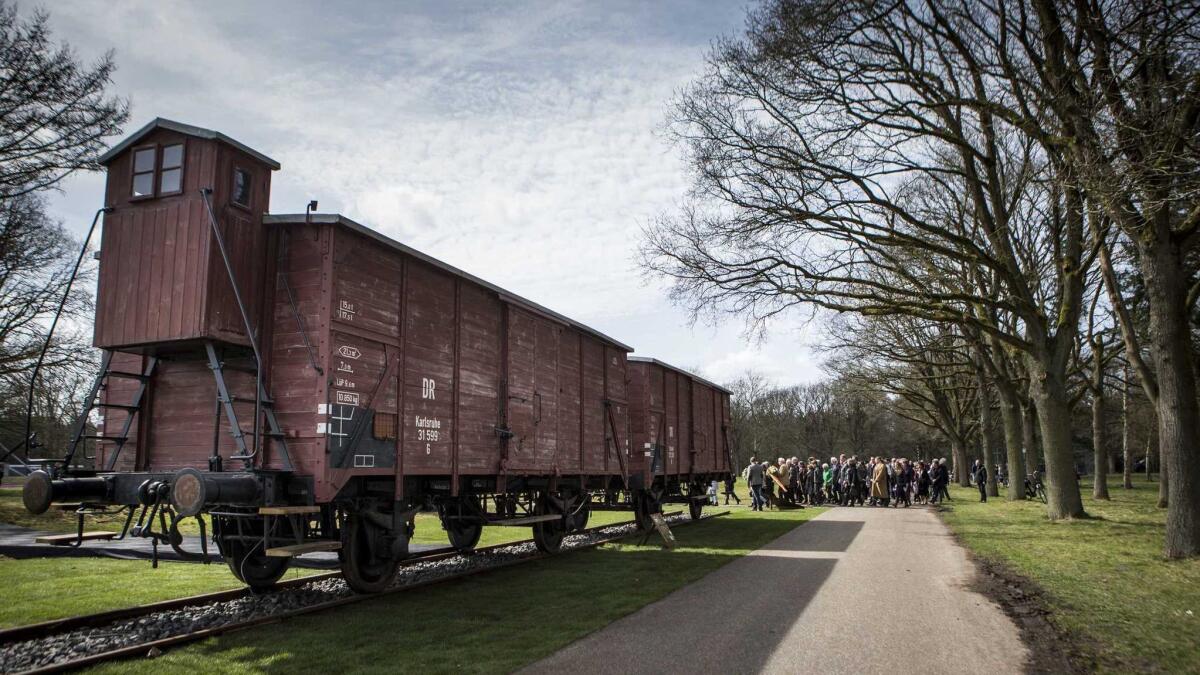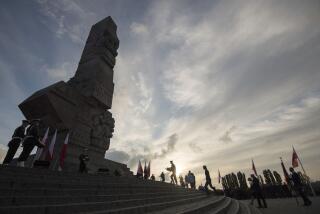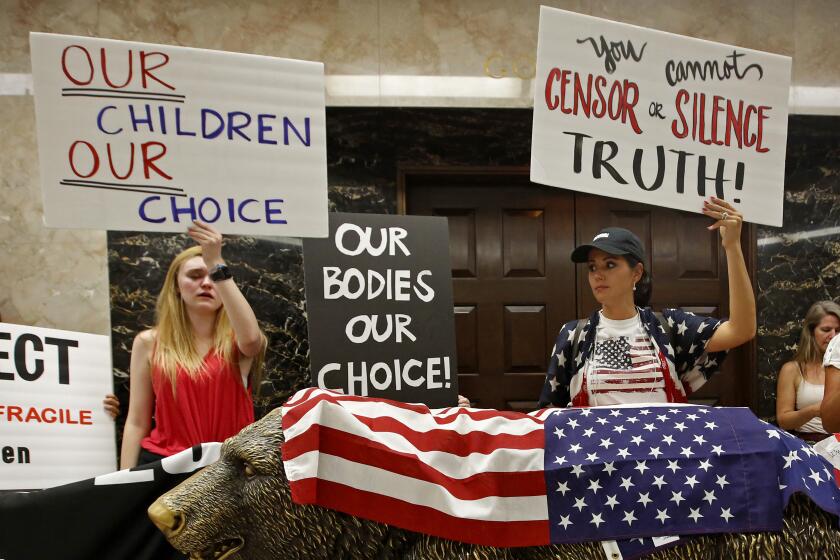At the peak of the Holocaust, Nazis murdered more than 14,000 Jews a day, scholar says

- Share via
In the ledger of evils perpetrated by humans, Operation Reinhard holds a distinct place. Over 21 months starting in March 1942, Nazi forces and their collaborators rounded up 1.7 million Jews from 393 Polish towns and ghettos and dispatched them in tightly packed rail cars to three camps in German-occupied Poland — Sobibor, Treblinka and Belzec.
At these three killing centers, members of Poland’s once-thriving Jewish community were murdered with such efficiency and ruthlessness that, of roughly 1.5 million Jews who passed through their gates, a mere 102 would survive to bear witness. By November 1943, when Operation Reinhard ended, essentially no Polish Jews were left for the Germans to kill.
In a bid to capture the scope and intensity of genocides, a Tel Aviv University researcher has dissected Operation Reinhard and found its dark heart.
Biomathematician Lewi Stone drew upon a painstaking accounting of Nazi train schedules to analyze the “kill rate” of Jews between February 1942 and December 1944. Within Operation Reinhard’s 21-month campaign of murder, he discovered a 92-day period that stands out for its ferocity.
In August, September and October of 1942, he calculated, German forces and their allies in Poland killed at least 1.32 million Jews. That averages out to 14,348 per day, every day. Virtually all victims were from Poland and its immediate neighbors.
This concentration of murders in a three-month period “likely created substantial confusion among its victims, and its speed would have made the possibility of organized resistance difficult to coordinate in time,” Stone wrote in a study published this week in the journal Science Advances. “The massacre was effectively over before there was time for an organized response.”
Stone, also a mathematics professor at RMIT University in Melbourne, Australia, uses authoritative estimates of the Holocaust’s toll on Jews — which range from 5.1 million to 6.2 million — to reckon that as many as a quarter of the Nazis’ Jewish victims were murdered during these three months of Operation Reinhard. It appears to have taken place at roughly the same time that German forces, having invaded the Soviet Union and been thrown back from the outskirts of Moscow, were advancing instead on Stalingrad. Historians have noted that around this time, Adolf Hitler ordered his plan for the “final solution of the Jewish question” to be accelerated.
Documents recently unearthed from United Nations archives also reveal that as early as December 1942, the governments of the United States, Britain and the Soviet Union were aware that at least 2 million Jews had been murdered and an additional 5 million were at risk of being killed. Though they were preparing war crimes charges against Hitler and his generals on the basis of survivors’ reports, the Allied powers did little to protect or provide sanctuary to Europe’s Jews.
Operation Reinhard was launched with the March 1942 opening of the Belzec death camp near Poland’s border with modern-day Ukraine. Starting in late July 1942, Treblinka’s gas chambers would begin to kill Jews from the Warsaw Ghetto. The expanded death camp of Sobibor reopened soon after, fulfilling Gestapo chief Heinrich Himmler’s July 19, 1942, order that, with few exceptions, all Jews within German-occupied Poland should be killed by the end of the year.
An estimated 292,000 of the 1.32 million who died during this spasm of violence were killed with bullets by shooting squads called the Einsatzgruppen. The remainder were slain by poison gas within hours of their arrival at the death camps, Stone discerned.

This video plots the number of victims deported to three Nazi death camps each month, starting from Jan. 1, 1942. Almost all deportees were murdered.
To clarify the rate at which Jews were murdered in the course of Operation Reinhard, Stone turned to detailed railway schedules compiled by Israeli historian Yitzakh Arad. These schedules included data on 480 train deportations to Sobibor, Belzec and Treblinka carried out by the German National Railway during this period.
In an effort to glean the full extent of the Nazis’ genocidal machine, Stone then incorporated the well-documented death tolls from Auschwitz-Birkenau in western Poland and from the Einsatzgruppen, which were active across the countries that German troops had entered, including the Soviet Union.
By December 1942, long before Operation Reinhard formally ended, the rate of train deportations — and of murders at the three camps — slowed markedly, Stone found. It wasn’t that the Nazis had a change of heart. Rather, Stone wrote, the plunging death rate “simply reflects that there were very few Jews left to murder” in occupied Poland. The final remnants of the Jewish community in Bialystock were rounded up in November and December of 1942 and sent to Treblinka.
By mid-July of 1942, the Nazis began deporting Dutch Jews to concentration camps and killing centers in Germany and Poland. The Jews of Norway followed by late October of 1942.
The remaining Jewish populations of Europe were dispatched to Auschwitz-Birkenau, which saw what Stone called “exceptionally high kill rates” in 1944, when Hungarian Jews were sent there in large numbers.
Some historians have suggested that the 1994 Rwanda genocide, in which an estimated 800,000 members of the Tutsi tribe were murdered by Hutus in a span of about 100 days, might have exceeded the Holocaust in the pace of its genocidal mayhem. According to Stone’s calculations, it did not.
During the three most murderous months of Operation Reinhard, the intensity with which the Nazis sought to kill Jews was 83% higher than that seen in Rwanda’s genocide, Stone found. In both its extent of killing and in the expanse of space over which it unfolded, the Holocaust represents a more extreme manifestation of organized violence against a single group, he wrote.
Historians, social scientists, policymakers and journalists “have consistently relied on inaccurate assessments that greatly underestimated the Holocaust kill rate during Operation Reinhard,” Stone concluded. “These underestimates have been repeated for over two decades without substantial criticism, a pattern that has effectively rewritten the history of the Holocaust in a way that diminishes its historical standing and the scale of human life it encompasses.”
The new study is part of an effort to push scholarship on the Holocaust — and on the phenomenon of genocide generally — beyond aggregated numbers of the dead, and to reveal their inner dynamics. Understanding the patterns of violence that lie between a genocidal event’s beginning and end points might uncover what factors touch them off, sustain or accelerate them, or bring them to a close, Stone suggested.
Focusing on pivotal phases of the Holocaust may also offer new perspective on death tolls that either become the subject of dry academic debate or defy easy comprehension by the public.
A recent scholarly estimate — that between 5.4 million and 5.8 million Jews were murdered over the Holocaust’s four years — has “limited explanatory power because in the end we are left with a single aggregate number that is bewilderingly large and difficult for the human mind to relate to,” Stone wrote. “With all this complexity, here we ask, Are there any simple definitive killing patterns that can be distilled from this period that can shed better light on the large-scale dynamics of the large-scale Nazi operation?”
Twitter: @LATMelissaHealy
MORE IN SCIENCE







